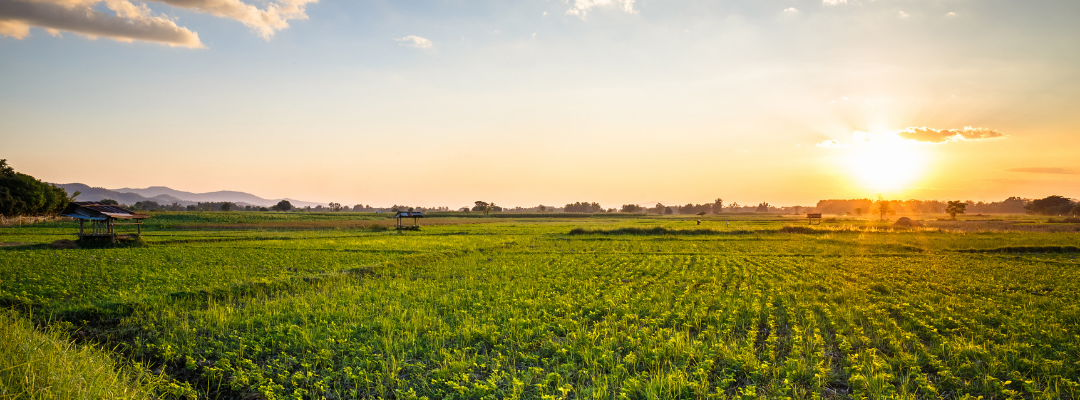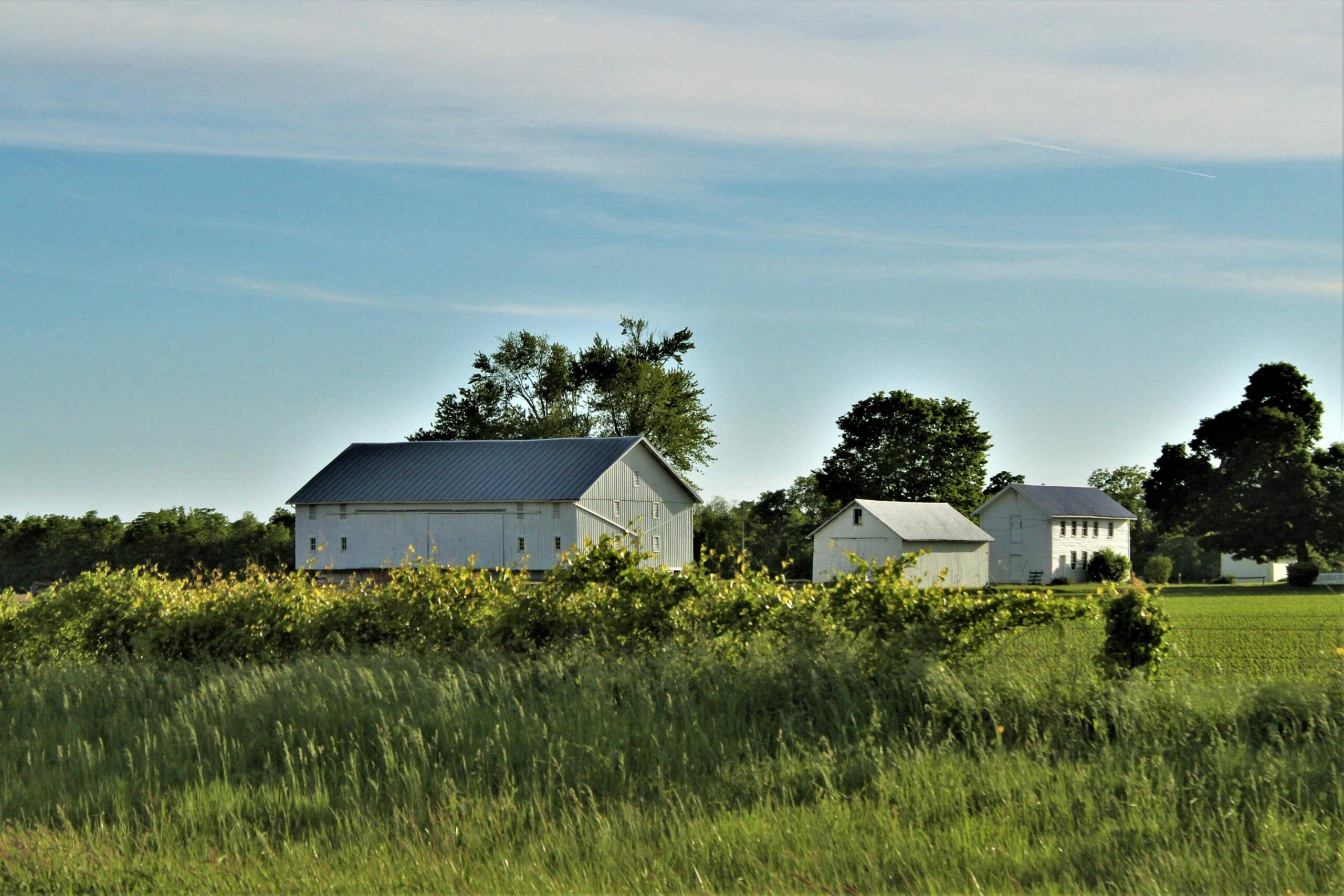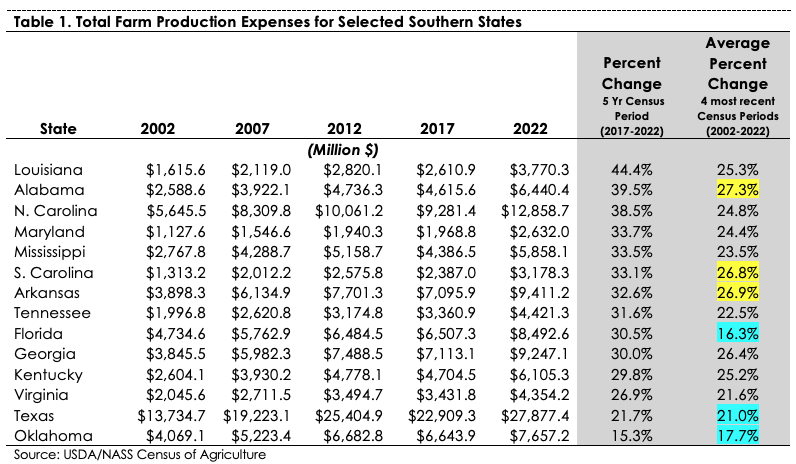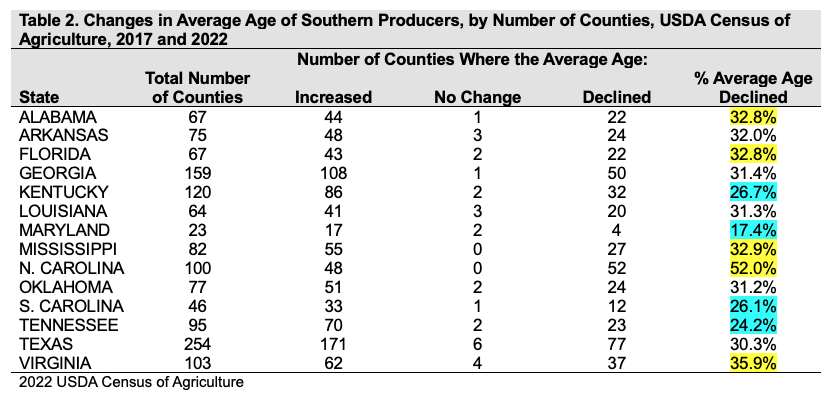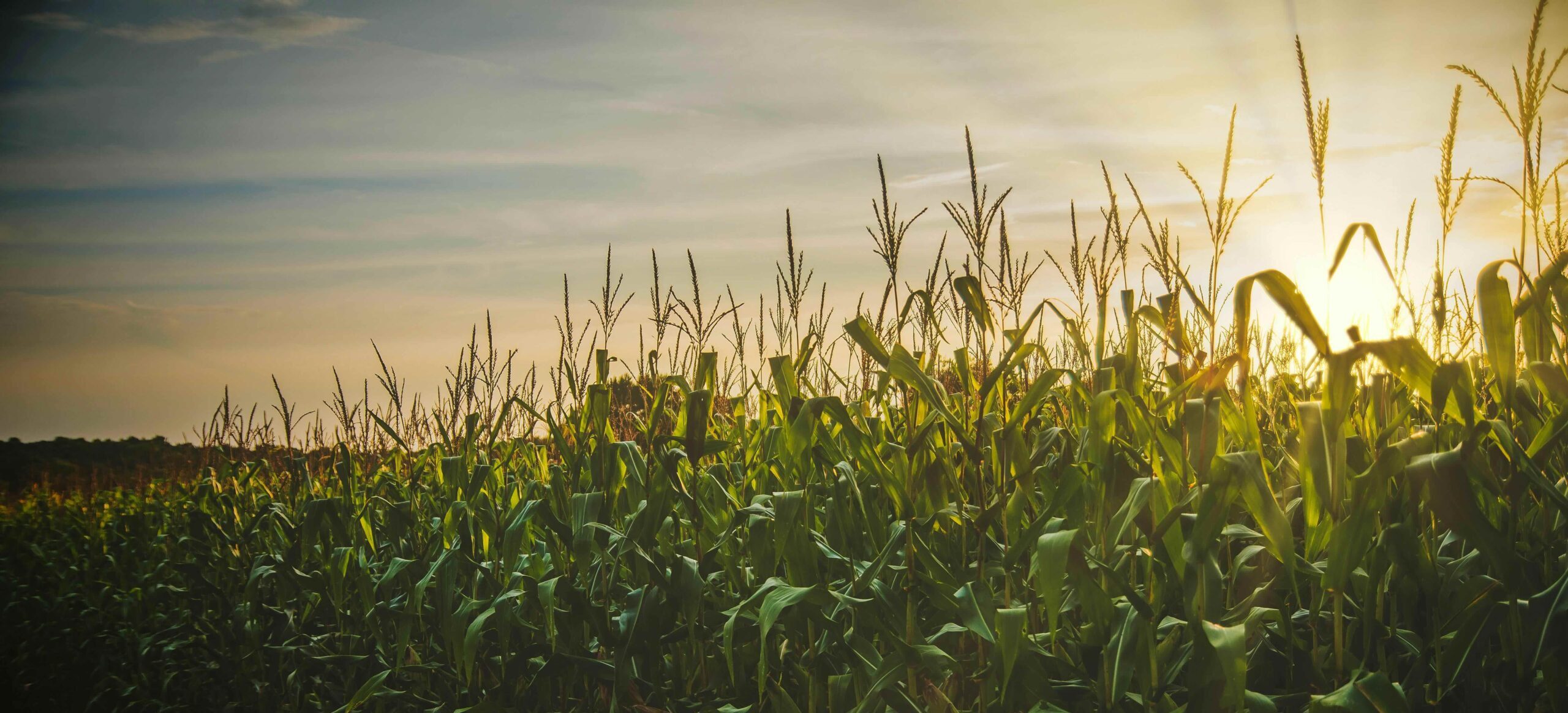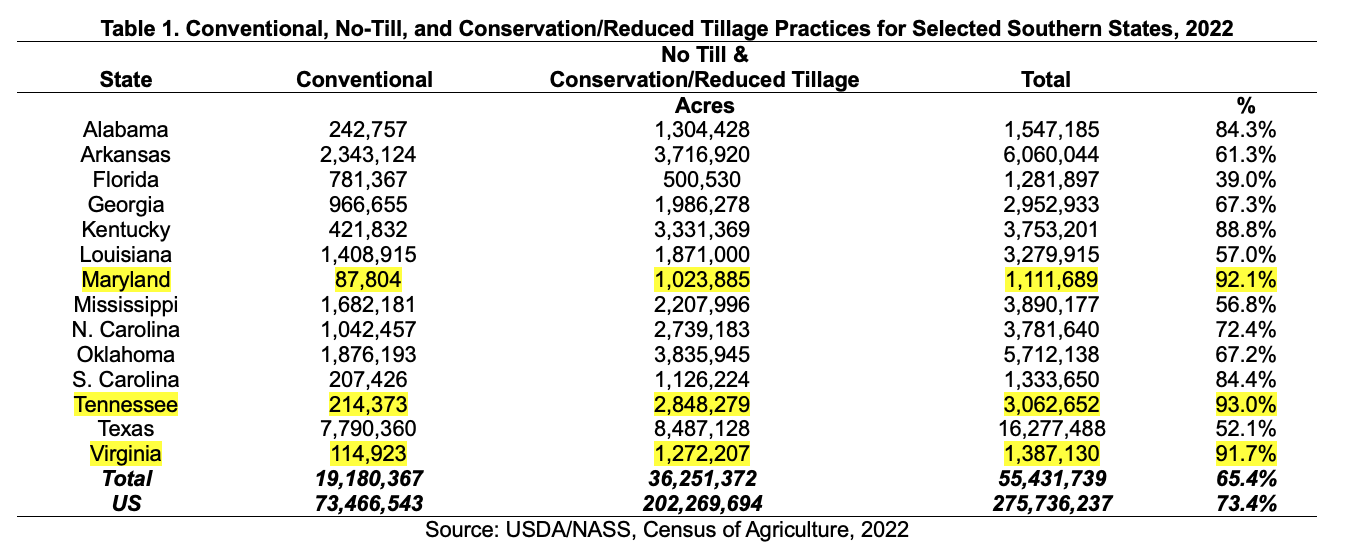U.S. agricultural producers use hired farm labor for field crops, livestock, and nursery operations, for grading and sorting of agricultural products, for supervisory roles, and other areas. According to USDA’s Economic Research Service (ERS), mechanization led to greater productivity and a reduction in the need for labor, both self-employed farm operators (including family members) and hired workers, from 1950 to 1990. Since 1990, however, U.S. employment of agricultural workers has stabilized. For the 1950 to 1990 period, labor from self-employed and family members experienced a greater decline (74 percent) than hired farm labor (51 percent reduction). Even though hired farm labor comprises only one percent of all U.S. wage and salary workers, hired labor is important for agriculture to succeed (USDA/ERS, 2025).
Table 1 contains census of agriculture data for the number of hired farm laborers and farms with hired farm labor from 2012 to 2022, along with the ten-year average change for the southern states. There should be no surprise that all southern states have witnessed a decrease in both workers and farms with hired farm labor (for Maryland, the number of farm workers is essentially flat, but farms with hired labor are declining). Kentucky leads in the loss of hired farm labor over the ten-year average at -23.2%, followed by Oklahoma (-18.1%). Kentucky also leads in the decrease in the number of farms with hired farm labor at -18.7%, followed by Mississippi (-16.6%). For Kentucky during this timeframe, there was a shift away from tobacco production, a highly labor-intensive crop. Florida and Georgia have lost the fewest workers as measured by the ten-year average (USDA/NASS, 2025a). The prevailing reasons for the decrease in hired farm labor are the aging of the farm workforce, the lack of new immigrants entering agriculture, the displacement of labor by technology and machinery, costs, a lack of interest, and a preference for a better life-work balance.
| Table 1. Number of Hired Farm Laborers (Workers) and Farms with Hired Farm Labor for Selected Southern States | ||||||||
| 2012 | 2017 | 2022 | 2012-2022 Ave Δ | |||||
| State | Workers | Farms | Workers | Farms | Workers | Farms | Workers | Farms |
| Kentucky | 68,586 | 19,586 | 52,701 | 16,530 | 40,464 | 12,939 | -23.2% | -18.7% |
| Oklahoma | 51,119 | 18,108 | 42,431 | 16,794 | 34,323 | 13,181 | -18.1% | -14.4% |
| Mississippi | 32,307 | 10,581 | 27,166 | 9,105 | 21,936 | 7,345 | -17.6% | -16.6% |
| N. Carolina | 78,012 | 14,469 | 67,496 | 12,492 | 55,536 | 10,464 | -15.6% | -14.9% |
| Virginia | 46,561 | 12,718 | 39,657 | 10,954 | 33,719 | 8,969 | -14.9% | -16.0% |
| Alabama | 32,948 | 11,216 | 26,136 | 9,881 | 24,228 | 7,850 | -14.0% | -16.2% |
| Texas | 160,392 | 56,401 | 143,763 | 50,892 | 120,468 | 40,327 | -13.3% | -15.3% |
| Tennessee | 42,737 | 15,071 | 40,056 | 14,170 | 32,240 | 11,222 | -12.9% | -13.4% |
| Louisiana | 26,632 | 7,838 | 23,019 | 6,789 | 20,863 | 5,951 | -11.5% | -12.9% |
| S. Carolina | 23,398 | 5,851 | 20,938 | 5,254 | 18,730 | 4,449 | -10.5% | -12.8% |
| Arkansas | 33,104 | 11,715 | 29,047 | 10,373 | 28,162 | 9,051 | -7.7% | -12.1% |
| Georgia | 51,156 | 12,258 | 48,972 | 11,737 | 44,537 | 9,891 | -6.7% | -10.0% |
| Florida | 107,192 | 13,291 | 96,247 | 12,207 | 96,588 | 11,680 | -4.9% | -6.2% |
| Maryland | 14,705 | 3,536 | 15,143 | 3,410 | 14,820 | 2,992 | 0.4% | -7.9% |
| Source: Censuses of Agriculture | ||||||||
The 2022 agriculture census indicates that hired farm labor ranked third in a ranking of production expenses for southern states, preceded by feed purchases and livestock and poultry purchased/leased (see Menard SAT “Census of Agriculture Production Expenses for Southern States, 11/11/24). For all farms, data from the most recent agriculture census indicate that wages and salaries plus contract labor are 12 percent of production expenses. However, this percentage increases to 42 percent for greenhouse and nursery operations and 40 percent for fruit and tree nut operations. For immigrant labor costs in dairies and nurseries, costs as a share of gross revenues are near their 20-year highs. Hired farm labor wages vary by state and farm region. For 2024, the hourly wage rates for hired farm labor in the southern states range from $15.25 (Arkansas, Louisiana, and Mississippi) to $19.15 per hour (Maryland). For that same timeframe, hired farm labor ranges from $14.86 to $18.13 per hour for crop operations and $14.73 to $17.51 per hour for livestock operations (USDA/ERS, 2025; USDA/NASS 2025a & 2025b).
For 2022, the most common agriculture operation type for each state where hired farm labor was utilized is indicated in Table 2. The table also provides information for each state on the operation type having the largest hired farm labor production costs. For example, beef cattle (NAICS 112111) farming was the most common operation type for hired farm labor in Alabama, Kentucky, Oklahoma, Tennessee, and Texas. Greenhouse, nursery, and floriculture production operations had the highest hired farm labor production costs for Alabama, Florida, Maryland, North Carolina, South Carolina, Tennessee, and Virginia.
| Table 2. Most Common Operation Type for Hired Farm Labor and Largest Hired Farm Labor Production Costs for Selected Southern States, 2022 | ||
| State | Most Common (NAICS) | Largest Production Costs (NAICS) |
| Alabama | Beef Cattle (112111) | Greenhouse, Nursery, & Floriculture Production (1114) |
| Arkansas | Oilseed & Grain Crops (1111) | Oilseed & Grain Crops (1111) |
| Florida | Greenhouse, Nursery, & Floriculture Production (1114) | Greenhouse, Nursery, & Floriculture Production (1114) |
| Georgia | Fruit & Tree Nut Farming (1113) | All Other Crop Farming (11194/11199*) |
| Kentucky | Beef Cattle (112111) | Other Animal Production (1129**) |
| Louisiana | Oilseed & Grain Crops (1111) | Oilseed & Grain Crops (1111) |
| Maryland | Greenhouse, Nursery, & Floriculture Production (1114) | Greenhouse, Nursery, & Floriculture Production (1114) |
| Mississippi | Oilseed & Grain Crops (1111) | Oilseed & Grain Crops (1111) |
| N. Carolina | Greenhouse, Nursery, & Floriculture Production (1114) | Greenhouse, Nursery, & Floriculture Production (1114) |
| Oklahoma | Beef Cattle (112111) | Beef Cattle (112111) |
| S. Carolina | Vegetable & Melon Farming (1112) | Greenhouse, Nursery, & Floriculture Production (1114) |
| Tennessee | Beef Cattle (112111) | Greenhouse, Nursery, & Floriculture Production (1114) |
| Texas | Beef Cattle (112111) | Beef Cattle (112111) |
| Virginia | Greenhouse, Nursery, & Floriculture Production (1114) | Greenhouse, Nursery, & Floriculture Production (1114) |
| *Hay and peanut farming**Horse/equine productionSource: Censuses of Agriculture | ||
There are a couple of interesting trends moving forward that may affect southern states and the use of hired farm labor. Long-distance migrations from home to work are declining —farmworkers are more settled. Fewer farmworkers are pursuing the seasonal follow-the-crop migration. Also, women as farmworkers is an increasing trend. (USDA/ERS, 2025; USDA/NASS, 2025a).
Reference
USDA Economic Research Service (ERS). 2025. “Farm Labor.” Available at https://www.ers.usda.gov/topics/ farm-economy/farm-labor.
USDA National Agricultural Statistical Service (NASS). 2025a. Census of Agriculture Reports. Available at https://www.nass.usda.gov/AgCensus/index.php.
USDA National Agricultural Statistical Service (NASS). 2025b. “Quick Stats.” Available at https://quickstats.nass.usda.gov/
Menard, R. Jamey. “Hired Farm Labor Trends.” Southern Ag Today 5(34.1). August 18, 2025. Permalink
